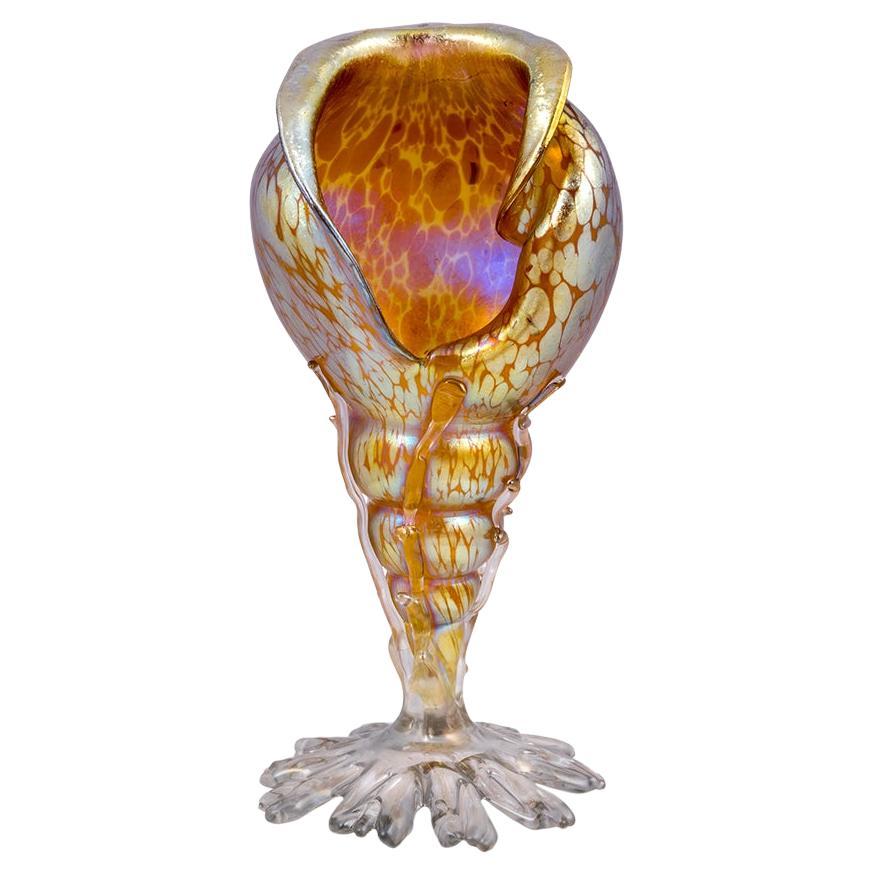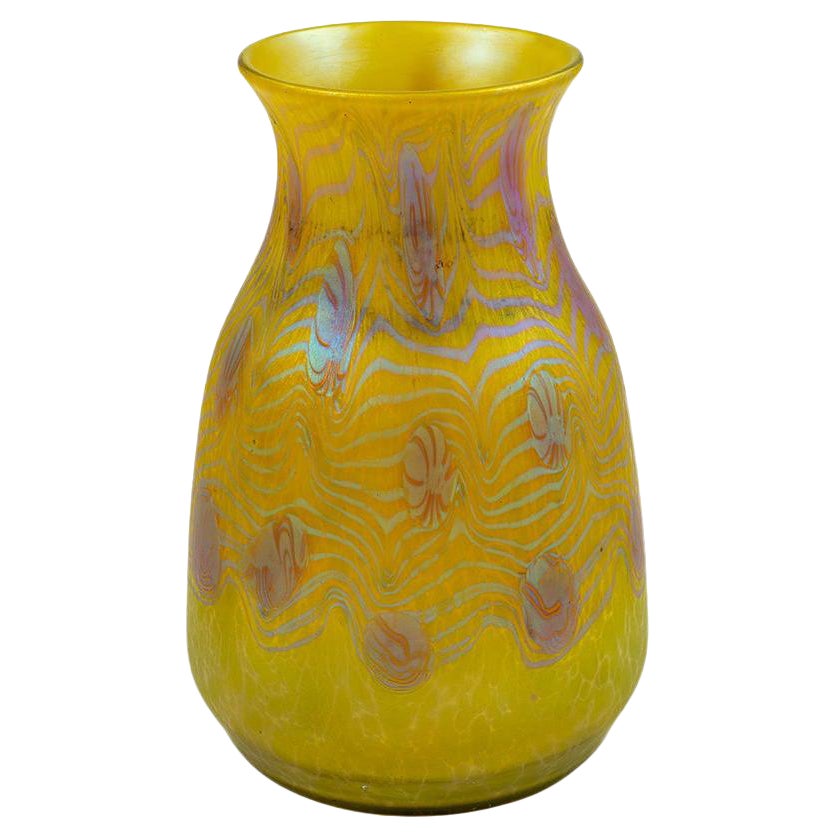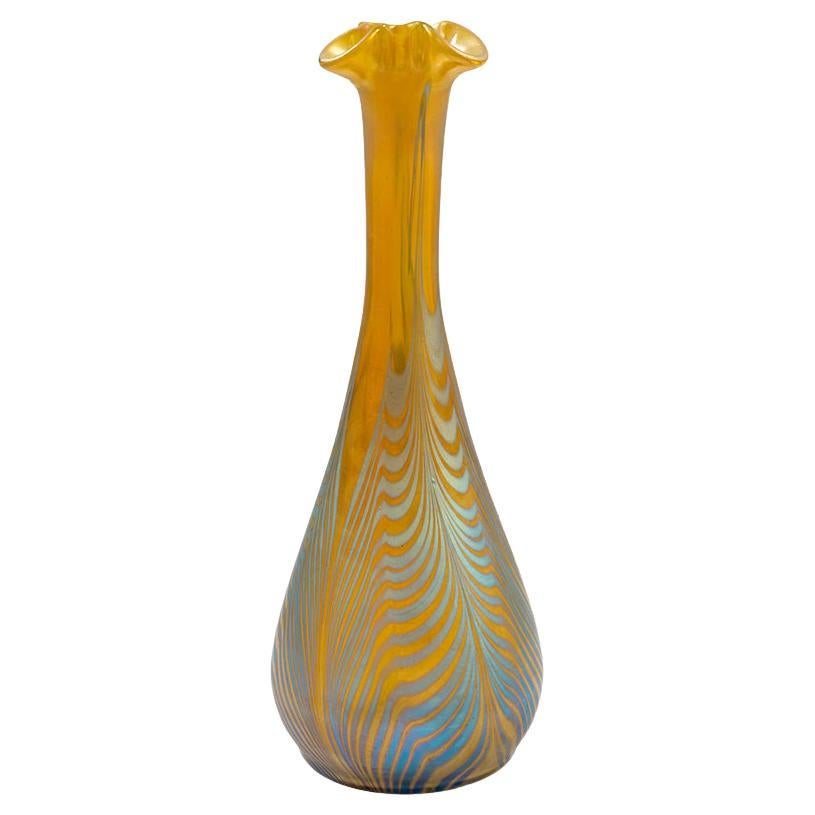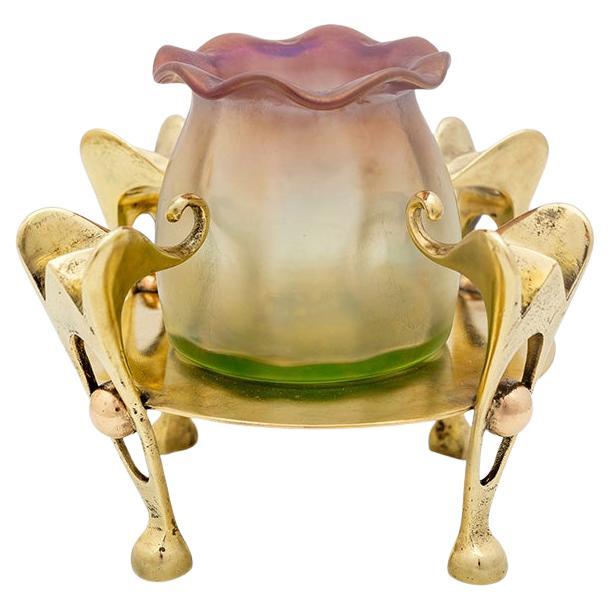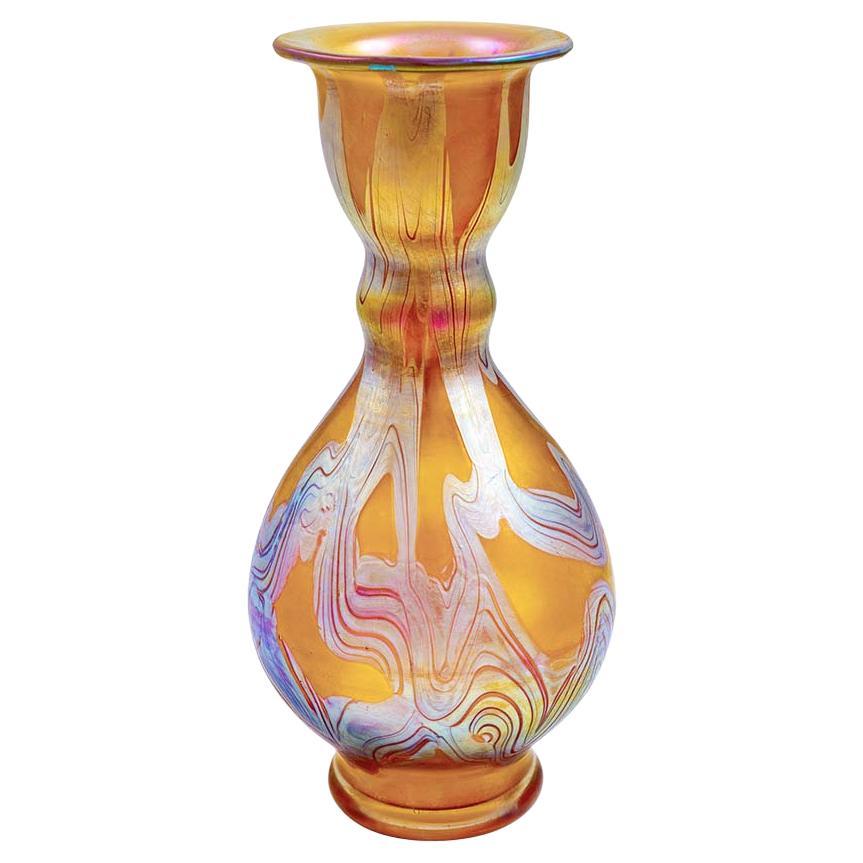Items Similar to After Loetz, Bohemian Jugendstil Iridescent Art-Glass Flower Vase, ca. 1900
Want more images or videos?
Request additional images or videos from the seller
1 of 10
After Loetz, Bohemian Jugendstil Iridescent Art-Glass Flower Vase, ca. 1900
About the Item
This large elegant, museum quality flower vase was probably made by Johann LOETZ Witwe Glassworks (Klostermühle, Bohemia, circa 1900) is a superior example of Jugendstil ~ Art Nouveau luxury object.
The semi-translucent art glass strikes a spectator not only with the uniqueness of its surface, reminiscent of crocodile skin, but also with unexpected color scheme - a combination of dark brown, old gold and green, covered with craquelure; against the background of iridescent violet. The vase is framed by outstandingly designed bronzed & patinated pewter mounting, consisting of simple large handles, almost geometric-form; with one wreath of leaves, crowning the neck; and the second, forming a base. The simplicity of the forms both, the glass vessel and the mounting are generating extremely interesting decorative effects, inherent exclusively to Jugendstil ~ Art Nouveau era.
LOETZ Witwe Glassworks
In 1836, Johann Eisner established a glassworks in the Southern Bohemian town of Klostermühle, today part of the Czech Republic. The Art Nouveau Period was the glory years of the company. The glassworks created large numbers of its own new designs of iridescent, trailing art nouveau glass, sometimes in collaboration with well-known artists and designers like Marie Kirschner and Franz Hofstötter (aka Franz Hofstätter). The company’s success during this period had two prime drivers – the technical expertise of Prochaska and the business acumen of von Spaun. Loetz Witwe created many of its own designs, and also supplied glass commissioned by major customers like E. Bakolowits (Vienna) and Max Emanuel (London). The Great Depression in the late twenties and another fire in 1930 hit the company hard, and during the thirties the glassworks changed ownership several times, often had to close down for long periods and finally declared bancruptcy once more in 1939, following the German invasion of Czechoslovakia. The glassworks manufactured utilitarian glassware for the Third Reich throughout the war, but then ultimately closed down completely in 1947.
- Creator:Loetz Glass (Maker)
- Dimensions:Height: 16.75 in (42.55 cm)Diameter: 6.5 in (16.51 cm)
- Style:Art Nouveau (Of the Period)
- Materials and Techniques:
- Place of Origin:
- Period:1900-1909
- Date of Manufacture:circa 1900
- Condition:Wear consistent with age and use.
- Seller Location:New York, NY
- Reference Number:1stDibs: LU2819320681282
About the Seller
5.0
Vetted Seller
These experienced sellers undergo a comprehensive evaluation by our team of in-house experts.
Established in 1993
1stDibs seller since 2017
68 sales on 1stDibs
Typical response time: 2 hours
- ShippingRetrieving quote...Ships From: New York, NY
- Return PolicyA return for this item may be initiated within 10 days of delivery.
More From This SellerView All
- French Art Nouveau Iridescent Stoneware & Bronze Vase or Cachepot, ca. 1900sLocated in New York, NYFrench Art Nouveau Ocean Life Theme Vase Cachepot Iridescent Stoneware & Patinated Bronze Crab Appliqué ca. 1900s ABOUT We present here a most unusual and utterly decorative Fren...Category
Antique Early 1900s French Art Nouveau Vases
MaterialsStoneware
- Japanese Art Nouveau, Awaji Ware Art Studio Pottery Flower Vase, Ca. 1900By Awaji PotteryLocated in New York, NYDIMENSIONS: Height: 12.5 inches Width: 6.75 inches Depth: 6.75 inches ABOUT AWAJI POTTERY Awaji pottery was made on the Japanese island of the same name between 1830 and 19...Category
Antique Early 1900s Japanese Art Nouveau Vases
MaterialsCeramic
- Japanese Art Nouveau Awaji Ware Art Studio Pottery Flower Vase, ca. 1900sLocated in New York, NYJapanese Art Nouveau Flower Vase Awaji Ware Art Studio Pottery ca. 1900s ABOUT AWAJI WARE ART STUDIO POTTERY Awaji pottery was made on the Japanese island of the same name between...Category
Antique Early 1900s Japanese Art Nouveau Vases
MaterialsPottery
- Loetz Jugenstil Art Glass, Bronze & Marble Lamp ‘Fly Agaric Mushroom’, ca. 1900By Loetz GlassLocated in New York, NYAbout This museum-quality Bohemian Jugenstil lamp by Loetz Witwe Glassworks, ca. 1900 is distinguished by non-trivial composition, refine? forms of amazing proportions and the unique selection of materials. The Loetz art glass lamp shade in form of a fly agaric mushroom cap is of ideally organic form and color; and is flawless. The patinated bronze lamp base mounted on a red veined marble plinth is a work of art by itself. It consists of a tall, graceful mushroom stem and a plump baby-mushroom nestled against it in the middle of a moss-covered clearing, in the middle of which an elegant lizard made of cold-painted bronze froze in sensitive tension. Dimensions Height: 13 inches Depth: 5.5 inches Width: 6.5 inches Loetz Witwe Glassworks: In 1836, Johann Eisner established a glassworks in the Southern Bohemian town of Klostermühle, today part of the Czech Republic. The Art Nouveau Period was the glory years of the company. The glassworks created large numbers of its own new designs of iridescent, trailing art nouveau glass, sometimes in collaboration with well-known artists and designers like Marie Kirschner and Franz Hofstötter (aka Franz Hofstätter). The company’s success during this period had two prime drivers – the technical expertise of Prochaska and the business acumen of von Spaun. Loetz Witwe created many of its own designs, and also supplied glass commissioned by major customers like E. Bakolowits (Vienna) and Max Emanuel...Category
Antique Early 1900s Czech Jugendstil Table Lamps
MaterialsMarble, Bronze
- French Art Nouveau Patinated Bronze Sculptural Iris Vase, ca. 1900Located in New York, NYABOUT IRIS The iris is a special and mysterious flower. Not only because of its striking appearance, but also from an artistic and historical point of view. It is also like a work of art, as though created by Mother Nature. The unique leaves of this plant not only create wonderful shadow casts, but also look as if they were painted by hand. It's no wonder that iris acts as the muse for countless artists, and can be seen in many famous works of art. The iris was first spotted in the time of Pharaoh Thutmose, in 1504 BC. He had the iris inscribed into the wall reliefs of a temple as a sign of his power, as well as decorating his sceptre with motifs of the flower. Since then, the iris has been a symbol of victory in Egypt. But the symbolism of the iris goes further than that. In Japan, the flower represents courage and is the symbol of the boys' festival. In Islamic cultures, the iris is a symbol of prosperity. In Europe, the flower was a popular weapon symbol in the Middle Ages and stood for chivalry. And in Christianity, the iris was seen as a symbol of the trinity because of its three-part flowers. With more than 300 varieties, the iris is now the most popular flower among growers and gardeners following the rose. Countless artists use the iris in their works and the flower is present in all eras. You can see the flower on furniture, vases, jewelry, fabrics, sculptures, coats of arms and much more. Did you know that the iris is also called the sword lily? It's not a coincidence that it used to symbolize physical and emotional pain and suffering caused by a weapon. We also see the flower in religious art, where it's often associated with Mary and Jesus. The iris is also associated with the Greek goddess Iris, where the flower symbolizes reconciliation and divine messages. This is also reflected in many paintings. Finally, the iris is also visible in Dutch and Flemish still-life paintings. This can be in a religious form, incorporated into an object or as a decorative flower. In the Art Nouveau art movement, the iris (along with other plants, such as the birch) was often used as an expression of feminine beauty. With its almost otherworldly appearance, the iris is perfectly suited to the Art Nouveau aesthetic and is featured in many well-known works of art. The poet of that era, Hermann Hesse...Category
Antique Early 1900s French Art Nouveau Planters, Cachepots and Jardinières
MaterialsBronze
- Paul Dachsel for Turn Teplitz, Austrian Jugenstil Ceramic ‘Fern’ Vase, ca. 1900By Paul DachselLocated in New York, NYDETAILS: Fully marked on bottom. DIMENSIONS: height: 6.75 inches, width: 4.5 inches, depth: 4.5 inches ABOUT THE ARTIST Paul Dachsel (Czech, born circa 1880) was the son-in-law of Alfred...Category
Antique Early 1900s Austrian Art Nouveau Vases
MaterialsCeramic
You May Also Like
- Conch Shell Glass Vase Iridescent Handmade Loetz Austria Jugendstil, circa 1900By Loetz GlassLocated in Klosterneuburg, ATConch shell glass vase handmade by Johann Loetz Witwe Austria/Bohemia Jugendstil circa 1902 "Candia Papillon" Decoration. The extravagant Candia Papillon decor lends a special brilliance to the shell shape of this collectible. The iridescent quality of this decoration not only encompasses the outside of the intricately applied silver crumbled dots, but extends into the interior of the glass shell. A characteristic of this scroll vase...Category
Antique Early 1900s Austrian Jugendstil Vases
MaterialsArt Glass, Blown Glass
- Conch Shell Glass Vase Iridescent Handmade Loetz Austria Jugendstil, circa, 1900By Loetz GlassLocated in Klosterneuburg, ATConch shell glass vase handmade by Johann Loetz Witwe Austria/Bohemia Jugendstil circa 1902 "Candia Papillon" Decoration. The extravagant Candia Papillon decor lends a special brilliance to the shell shape of this collectible. The iridescent quality of this decoration not only encompasses the outside of the intricately applied silver crumbled dots, but extends into the interior of the glass shell. A characteristic of this scroll vase...Category
Antique Early 1900s Austrian Jugendstil Vases
MaterialsArt Glass, Blown Glass
- Austrian Jugendstil Glass Vase Yellow Iridescent circa 1903 LoetzBy Loetz GlassLocated in Klosterneuburg, ATAustrian Jugendstil glass vase lemon yellow circa 1903 Johann Loetz Witwe decor Phenomen Genre 3/430 Our vase bears the decor called Phenomen Genre 3/430, which was designed in 19...Category
Antique Early 1900s Austrian Jugendstil Vases
MaterialsBlown Glass
- Bohemian Glass Vase Loetz Austrian Jugendstil Yellow circa 1901By Loetz GlassLocated in Klosterneuburg, ATBohemian Glass Vase Loetz Austrian Jugendstil Yellow circa 1901 decoration PG 1/154 One of the main reasons for the big success of Loetz at the Pa...Category
Antique Early 1900s Austrian Jugendstil Vases
MaterialsArt Glass
- Vase in brass mount Bohemian Glass Loetz Krasnik Pink ca. 1900 ViennaBy Loetz GlassLocated in Klosterneuburg, ATSmall but elegant glass vase in a polished brass mount. The vase was designed by Antoinette Krasnik (School of Koloman Moser). The vase was produced by the Bohemian glass manufacture...Category
Antique Early 1900s Austrian Jugendstil Vases
MaterialsMetal, Brass
- Vase Iridescent Glass Johann Loetz Witwe Austrian Jugendstil Orange SilverBy Loetz GlassLocated in Klosterneuburg, ATVase iridescent glass Johann Loetz Witwe Austrian Jugendstil "PG 7773" decoration In the 1890s, the Loetz company tried to break with the convention of the regional glass production...Category
Antique 1890s Austrian Jugendstil Glass
MaterialsGlass
Recently Viewed
View AllMore Ways To Browse
Art Glass Antique
Antique Art Glass
Antique Glass Flower
Glass Art Framed
Art Glass Flower
Large Glass Flower
Commission Glass
Bohemian Art
Green Glass Frames
Hand Made Glass Flower
Ca Glass Art
Antique Gold Glasses Frames
Gold Flower Vase
Gold And Flower Vases
Black Vase With Flowers
Antique Brown Glass Vase
Glass Art Green Large
Glass Vase Germany

